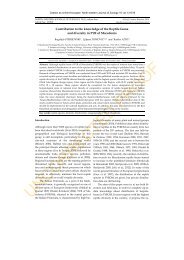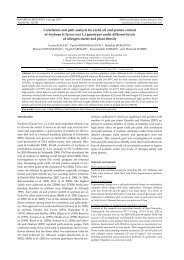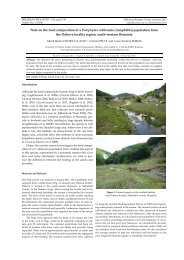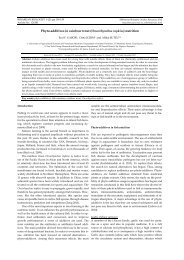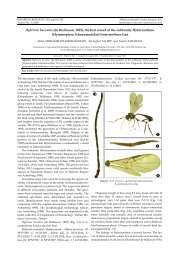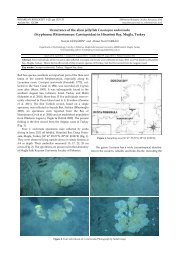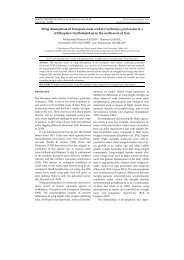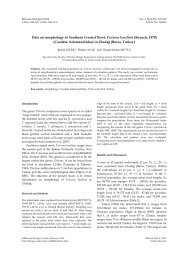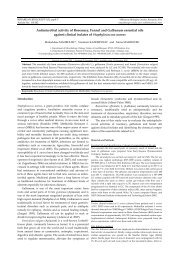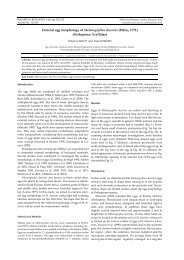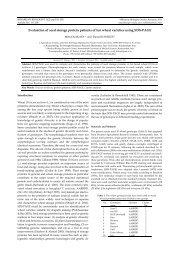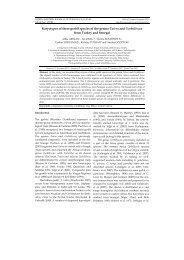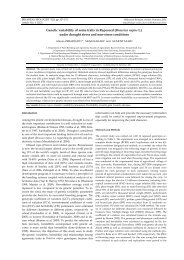New records and zoogeographic classification of amphibians and ...
New records and zoogeographic classification of amphibians and ...
New records and zoogeographic classification of amphibians and ...
Create successful ePaper yourself
Turn your PDF publications into a flip-book with our unique Google optimized e-Paper software.
Amphibians <strong>and</strong> reptiles from Bosnia <strong>and</strong> Herzegovina<br />
Figure 2. (continued)<br />
[for details see the previous page]<br />
The highest number <strong>of</strong> species at one locality<br />
was recorded in Karaotok (Hutovo Blato) – four<br />
amphibian species (B. bufo, H. arborea, R. dalmatina,<br />
P. ridibundus) <strong>and</strong> four reptile species (Pseudopus<br />
apodus, H. gemonensis, N. natrix, N. tessellata) from<br />
six families, <strong>and</strong> in the Sutjeska region where we<br />
found three amphibian species (Salam<strong>and</strong>ra salam<strong>and</strong>ra,<br />
B. bufo, Rana graeca) <strong>and</strong> five reptile species<br />
(L. viridis complex, P. muralis, A. fragilis complex,<br />
N. natrix, Vipera berus) from seven families<br />
(Table 1, Fig. 3).<br />
We classified the herpet<strong>of</strong>auna <strong>of</strong> BaH into 12<br />
chorotypes in total (Table 2, Fig. 4). In <strong>amphibians</strong><br />
we identified eight chorotypes (the most dominant<br />
being the European with 27.8% <strong>of</strong> number <strong>of</strong> species),<br />
in reptiles we identified nine chorotypes (the<br />
most dominant being the Eastern-Mediterranean<br />
chorotype with 37.9% <strong>of</strong> number <strong>of</strong> species). None<br />
<strong>of</strong> the species is endemic for BaH, but eight Balkan<br />
endemics occur here accounting for 17.0% <strong>of</strong> all<br />
amphibian <strong>and</strong> reptile species <strong>of</strong> BaH (see Table<br />
2).<br />
Chorotype comparison <strong>of</strong> BaH with the three<br />
regions <strong>of</strong> the Balkan Peninsula (Fig. 4; species<br />
lists are in Table 2 <strong>and</strong> Appendix 1), showed that<br />
the number <strong>of</strong> amphibian chorotypes is the same<br />
329<br />
in all regions with the exception <strong>of</strong> the Euro-<br />
Siberian chorotype which is only represented in<br />
the NW <strong>and</strong> E Balkans, but not in BaH <strong>and</strong> the S<br />
Balkans. Another significant difference is formed<br />
by the Eastern-Mediterranean chorotype which is<br />
dominant in the S Balkans (36.8%), while only<br />
weakly represented in the NW Balkans (5.0%) <strong>and</strong><br />
moderately in BaH <strong>and</strong> the E Balkans (16.7% <strong>and</strong><br />
18.2%, respectively). Further, the Central-<br />
European chorotype is represented by lower relative<br />
number <strong>of</strong> species in BaH (5.6%) <strong>and</strong> the S<br />
Balkans (5.3%) than in the NW <strong>and</strong> E Balkans<br />
(15.0% <strong>and</strong> 13.6%, respectively). The European<br />
chorotype was the most dominant within <strong>amphibians</strong><br />
in all Balkan regions with the exception<br />
<strong>of</strong> the S Balkans, where the Eastern-Mediterranean<br />
chorotype is dominant.<br />
Representation <strong>of</strong> the reptile chorotypes in all<br />
Balkan regions is also very similar in general, with<br />
the exception <strong>of</strong> an extra chorotype in the NW<br />
Balkans (Western-Mediterranean chorotype; presence<br />
<strong>of</strong> Lacerta bilineata), <strong>and</strong> an extra chorotype in<br />
the E Balkans (Centralasiatic-European; presence<br />
<strong>of</strong> Eremias arguta). On the other h<strong>and</strong>, the Mediterranean<br />
chorotype represented by H. turcicus is<br />
missing in the E Balkans. Frequencies <strong>of</strong> the other



